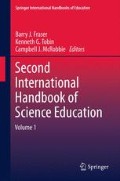Abstract
In this chapter, we first review the two dominant accounts from the 1990s of the role of writing as a learning tool in science, including relevant classroom-based research, as a basis for analysing current research agendas in this area. The increased use of new technologies to practice science and represent processes and findings, linked to recognition of the multi-modal nature of science as a discourse, has led to new accounts of the role of writing in learning science at school. Current studies have begun to shift emphasis from pedagogical conditions focused only on writing to examining how writing relates to other representational modes in the learning process. This expanded view of the role of the languages of science as learning tools requires carefully constructed research studies of appropriate pedagogical strategies to support student learning about modal interdependency.
Access this chapter
Tax calculation will be finalised at checkout
Purchases are for personal use only
References
Anderberg, E., Svensson, L., Alvegard, C., & Johansson, T. (2008). The epistemological role of language use in learning: A phenomenographic intentional-expressive approach. Educational Research Review, 3, 14–29.
Bazerman, C. (2007). Genre and cognitive development: Beyond writing to learn. http://www3.unisul.br/paginas/ensino/pos/linguagem/cd/English/5i.pdf. Accessed November 28, 2007.
Bereiter, C., & Scardamalia, M. (1987). The psychology of written composition. Mahwah, NJ: Lawrence Erlbaum Associates.
Furtak, E., & Ruiz-Primo, M. (2008). Making students’ thinking explicit in writing and discussion: An analysis of formative assessment prompts. Science Education, 92, 799–824.
Galbraith, D., Van Waes, L., & Torrance, M. (2007). Introduction. In M. Torrance, L. Van Waes, & D. Galbraith (Eds.), Writing and cognition: Research and applications (pp. 1–10). Amsterdam: Elsevier.
Graham, S., & Perin, D. (2007a). A meta-analysis of writing instruction for adolescent students. Journal of Educational Psychology, 99, 445–476.
Graham, S., & Perin, D. (2007b). Writing next: Effective strategies to improve writing of adolescents in middle and high schools. New York: Alliance for Excellent Education.
Gunel, M., Akkus, R., Hohenshell, L., & Hand, B. (2004, April). Improving student performance on higher order cognitive questions through the use of the Science Writing Heuristic. Paper presented at the annual meeting of the National Association for Research in Science Teaching, Vancouver.
Gunel, M., Hand, B., & Prain, V. (2007) Writing for learning in science: A secondary analysis of six studies. International Journal for Mathematics and Science Education, 5, 615–637.
Halliday, M., & Martin, J. (1993). Writing science: Literacy and discursive power. London: Falmer Press.
Hand, B. (Ed.). (2007). Science inquiry, argument and language: A case for the Science Writing Heuristic. Rotterdam, The Netherlands: Sense Publishers.
Johnson-Laird, P. (1983). Mental models: Towards a cognitive science of language, inference and consciousness. Cambridge, MA: Harvard University Press.
Kellogg, R. T. (2008). Training writing skills: A cognitive perspective. Journal of Writing Research, 1, 1–26.
Kieft, M. (2006). The effects of adapting writing instruction to students’ writing strategies. Amsterdam: PrintPartners Ipskamp.
Klein, P. (2006). The challenges of scientific literacy: From the viewpoint of second-generation cognitive science. International Journal of Science Education, 28, 143–178.
Klein, P., Boman, J., & Prince, M. (2007). Developmental trends in a writing to learn task. In M. Torrance, L. Van Waes, & D. Galbraith (Eds.), Writing and cognition: Research and applications (pp. 201–218). Amsterdam: Elsevier.
Lavelle, E. (2007). Approaches to writing. In M. Torrance, L. Van Waes, & D. Galbraith (Eds.), Writing and cognition: Research and applications. Amsterdam: Elsevier.
Lemke, J. (2004). The literacies of science. In E. W. Saul (Ed.), Crossing borders in literacy and science instruction: Perspectives on theory and practice (pp. 33–47). Newark, DE: International Reading Association/National Science Teachers Association.
Lemke, J. (2008). Teaching all the languages of science: Words, symbols, images, and actions. http://www-personal.umich.edu/~jaylemke/papers/barcelon.htm. Accessed August 28, 2008.
Levin, T., & Wagner, T. (2006). In their own words: Understanding student conceptions of writing through their spontaneous metaphors in the science classroom. Instructional Science, 34, 227–278.
Martin, J. (2000). Design and practice: Enacting functional linguistics. Annual Review of Applied Linguistics, 20, 116–126.
Moje, E. B. (2007). Developing socially just subject-matter instruction: A review of the literature on disciplinary literacy teaching. Review of Research in Education, 31, 1–44.
Prain, V., & Hand, B. (1996). Writing and learning in secondary science: Rethinking practices. Teaching and Teacher Education, 12, 609–626.
Tynjala, P., Mason, L., & Lonka, K. (2001). Writing as a learning tool: An introduction. In P. Tynjala, L. Mason, & K. Lonka (Eds.), Studies in writing: Vol. 7. Writing as a learning tool: Integrating theory and practice (pp. 7–22). Boston: Kluwer Academic Publishers.
Unsworth, L. (2001). Teaching multiliteracies across the Curriculum: Changing contexts of text and image in classroom practice. Buckingham, UK: Open University Press.
Unsworth, L (2006). Towards a metalanguage for multiliteracies education: Describing the meaning-making resources of language-image interaction. English Teaching: Practice and Critique, 5(1), 55–76.
Author information
Authors and Affiliations
Corresponding author
Editor information
Editors and Affiliations
Rights and permissions
Copyright information
© 2012 Springer Science+Business Media B.V.
About this chapter
Cite this chapter
Hand, B., Prain, V. (2012). Writing as a Learning Tool in Science: Lessons Learnt and Future Agendas. In: Fraser, B., Tobin, K., McRobbie, C. (eds) Second International Handbook of Science Education. Springer International Handbooks of Education, vol 24. Springer, Dordrecht. https://doi.org/10.1007/978-1-4020-9041-7_88
Download citation
DOI: https://doi.org/10.1007/978-1-4020-9041-7_88
Published:
Publisher Name: Springer, Dordrecht
Print ISBN: 978-1-4020-9040-0
Online ISBN: 978-1-4020-9041-7
eBook Packages: Humanities, Social Sciences and LawEducation (R0)

